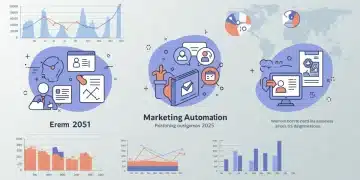Top 3 Blockchain Platforms 2025: Enterprise Adoption in US

This analysis offers a critical comparison of the top three blockchain platforms expected to drive significant enterprise blockchain adoption within the U.S. digital economy by 2025, detailing their technical merits and market positioning.
Comparing 2025’s Top 3 Blockchain Platforms for Enterprise Adoption in the U.S. Digital Economy (COMPARISON/ANALYSIS) is more than an academic exercise; it’s a critical look at the foundational technologies reshaping how businesses operate. As the digital economy accelerates, identifying robust, scalable, and secure blockchain solutions becomes paramount for U.S. enterprises seeking competitive advantage and operational efficiency.
The Evolving Landscape of Enterprise Blockchain in 2025
The year 2025 marks a pivotal moment for enterprise blockchain, moving beyond experimental phases to widespread implementation. Businesses are increasingly recognizing the transformative potential of distributed ledger technology (DLT) for supply chain management, financial services, digital identity, and more. This shift demands platforms that offer not just technological prowess but also regulatory compliance, ease of integration, and developer support.
The U.S. digital economy, characterized by its dynamism and rapid innovation, is at the forefront of this adoption wave. Companies are seeking solutions that can handle high transaction volumes, maintain data privacy, and provide interoperability with existing systems. The platforms leading this charge are those that have demonstrated resilience, flexibility, and a clear roadmap for future development.
Key Drivers for Enterprise Adoption
- Enhanced Security and Transparency: Blockchain’s inherent security features and immutable ledger offer unparalleled trust.
- Operational Efficiency: Automating processes through smart contracts reduces manual effort and errors.
- Cost Reduction: Streamlining operations and eliminating intermediaries can lead to significant savings.
- New Business Models: Enabling novel ways of interaction and value exchange across ecosystems.
Understanding these drivers is crucial for evaluating which platforms are best positioned for success. The competitive landscape is intense, with established players and innovative newcomers vying for market share. Enterprises must carefully assess their specific needs against the capabilities of each platform.
Hyperledger Fabric: A Pillar of Permissioned Blockchain
Hyperledger Fabric, an open-source project hosted by the Linux Foundation, stands out as a leading permissioned blockchain framework. Its modular architecture and emphasis on privacy make it particularly attractive for enterprises in the U.S. digital economy. Fabric allows participants to maintain control over their data, a critical factor for industries dealing with sensitive information.
Unlike public blockchains, Hyperledger Fabric operates on a private, permissioned network where all participants are known and verified. This model is ideal for consortiums and supply chains where trust among members is essential but full public transparency is not desired. Its flexibility in consensus mechanisms and support for various programming languages further enhance its appeal.
Core Strengths of Hyperledger Fabric
- Privacy and Confidentiality: Channel architecture enables private transactions between subsets of participants.
- Scalability: Designed to handle high transaction throughput, crucial for large enterprises.
- Modular Design: Components like consensus, ordering, and membership services can be customized.
- Smart Contract Support: Chaincode, written in Go, Node.js, or Java, allows for complex business logic.
Many financial institutions and supply chain giants have already adopted Hyperledger Fabric, leveraging its robust architecture for complex, multi-party processes. Its ongoing development and strong community support ensure its continued relevance in the rapidly evolving blockchain space. For U.S. enterprises prioritizing data control and tailored network configurations, Fabric remains a top contender for enterprise blockchain adoption.
Ethereum Enterprise Alliance (EEA) and Quorum: Public Chain Flexibility with Private Features
While Ethereum itself is a public blockchain, the Ethereum Enterprise Alliance (EEA) and its associated platforms like Quorum (now managed by ConsenSys) offer enterprise-grade solutions built on Ethereum’s robust foundation. This hybrid approach allows businesses to leverage the vast developer ecosystem and battle-tested security of Ethereum while incorporating necessary privacy and permissioned features.
Quorum, specifically, is an open-source protocol layer that runs on the Ethereum blockchain, designed to address the specific needs of financial institutions and enterprises. It offers transaction privacy, network permissions, and higher performance compared to the public Ethereum mainnet. This makes it an attractive option for businesses that want the benefits of a public blockchain’s innovation while maintaining control over their data and network access.
Advantages for Enterprise Use
- Hybrid Architecture: Combines public Ethereum’s strengths with private network needs.
- Developer Ecosystem: Access to a massive global community of Ethereum developers and tools.
- Transaction Privacy: Zero-knowledge proofs and other mechanisms ensure data confidentiality.
- Interoperability Potential: Native compatibility with the broader Ethereum ecosystem.
For U.S. enterprises exploring decentralized applications (dApps) and smart contract-driven solutions, Quorum presents a compelling option. Its ability to balance transparency with privacy, coupled with its strong ties to the widely adopted Ethereum standard, positions it as a significant player in the enterprise blockchain adoption landscape for 2025. This platform caters to organizations looking for both innovation and control.
Corda by R3: Streamlining Financial Services and Beyond
R3’s Corda is another powerful permissioned blockchain platform specifically designed for regulated industries, particularly financial services. Unlike traditional blockchains, Corda focuses on point-to-point communication between parties with a need-to-know basis, ensuring privacy and compliance. This approach limits data dissemination to only those directly involved in a transaction, a crucial feature for highly regulated environments.

Corda’s unique architecture, which doesn’t broadcast every transaction to every node, provides superior privacy and scalability for complex financial agreements. Its smart contract language, CorDapps, is designed for legal enforceability and integration with existing legal frameworks, making it highly suitable for banking, insurance, and capital markets. Its global network of institutions already leveraging Corda underscores its proven capabilities.
Key Features for Regulated Industries
- Transaction Privacy: Only relevant parties see transaction details.
- Legal Enforceability: Smart contracts designed to align with legal agreements.
- High Scalability: Efficient processing of transactions due to its unique architecture.
- Interoperability: Built to seamlessly integrate with traditional systems.
Corda’s specialized design addresses the intricate requirements of the financial sector, making it an indispensable tool for U.S. enterprises in this domain. Its focus on privacy, legal clarity, and direct communication positions it as a top choice for secure and compliant enterprise blockchain adoption, particularly where regulatory scrutiny is high and data confidentiality is paramount.
Comparative Analysis: Hyperledger Fabric vs. Quorum vs. Corda
When comparing 2025’s top 3 blockchain platforms for enterprise adoption in the U.S. digital economy, several critical factors emerge. Each platform offers distinct advantages tailored to different enterprise needs. Hyperledger Fabric excels in its modularity and channel-based privacy, making it versatile for various industries requiring segmented data access. Its open-source nature fosters broad community development and customization.
Quorum, leveraging the Ethereum ecosystem, provides a compelling hybrid solution. It appeals to enterprises seeking the innovation and vast developer pool of public Ethereum, combined with the privacy and permissioned control necessary for business operations. This makes it ideal for organizations looking to build complex dApps with controlled access.

Corda, on the other hand, is purpose-built for highly regulated environments, particularly financial services. Its unique point-to-point transaction model ensures unparalleled privacy and legal enforceability of smart contracts, addressing the stringent requirements of banking and insurance. The choice among these platforms often hinges on an enterprise’s specific industry, regulatory landscape, and desired level of privacy versus transparency.
Key Differentiators
- Consensus Mechanisms: Fabric offers pluggable consensus, Quorum uses a voting-based mechanism (e.g., Raft, Istanbul BFT), and Corda employs a notary service.
- Privacy Model: Fabric uses channels, Quorum uses private transactions, and Corda uses point-to-point communication.
- Smart Contract Language: Fabric supports multiple languages (Go, Node.js, Java), Quorum uses Solidity, and Corda uses Kotlin or Java.
- Target Industries: Fabric is general-purpose, Quorum is strong in finance and general enterprise, and Corda is specialized for finance.
The decision for U.S. enterprises adopting blockchain in 2025 will involve a detailed evaluation of these technical and operational nuances. The optimal platform is one that aligns perfectly with the business’s strategic goals, existing infrastructure, and long-term scalability requirements for enterprise blockchain adoption.
Challenges and Future Outlook for U.S. Enterprise Blockchain
Despite the significant advancements, enterprise blockchain adoption in the U.S. digital economy still faces hurdles. Interoperability between different blockchain networks remains a key challenge, as businesses often operate with multiple partners using diverse platforms. Regulatory clarity, while improving, still requires further refinement to provide a stable environment for widespread deployment. The talent gap, particularly for skilled blockchain developers and architects, also poses a constraint on rapid implementation.
However, the future outlook remains overwhelmingly positive. Continuous innovation in areas like layer-2 scaling solutions, cross-chain communication protocols, and standardized enterprise frameworks are addressing many of these challenges. The increasing investment from major tech companies and financial institutions indicates a strong belief in the long-term potential of blockchain to revolutionize business processes.
Emerging Trends and Opportunities
- Increased Interoperability: Development of bridges and protocols to connect different blockchains.
- Regulatory Sandboxes: Government initiatives to foster innovation while ensuring compliance.
- Sustainability Focus: Growing emphasis on energy-efficient blockchain solutions.
- Decentralized Finance (DeFi) Integration: Enterprises exploring DeFi applications for efficiency and new financial products.
As these trends mature, the U.S. digital economy is poised for accelerated enterprise blockchain adoption. The platforms discussed—Hyperledger Fabric, Quorum, and Corda—are at the forefront of this evolution, continually adapting and expanding their capabilities to meet the complex demands of modern businesses. Their ongoing development will shape the technological infrastructure of tomorrow’s digital commerce.
| Key Platform | Primary Benefit for U.S. Enterprise |
|---|---|
| Hyperledger Fabric | Modular, private, and scalable for diverse industry applications with data control. |
| Quorum (EEA) | Leverages Ethereum’s ecosystem with added privacy and permissioning for hybrid solutions. |
| Corda by R3 | Designed for highly regulated financial services, ensuring privacy and legal enforceability. |
| Overall Trend | Focus on privacy, scalability, and regulatory compliance for widespread enterprise integration. |
Frequently Asked Questions About Enterprise Blockchain Adoption
Top platforms in 2025 are characterized by their scalability, robust security features, data privacy controls, ease of integration with existing systems, and strong developer support. They must also demonstrate clear pathways for regulatory compliance within the U.S. digital economy.
For enterprises, privacy is paramount due to competitive intelligence, regulatory requirements, and the need to protect sensitive business data. Permissioned networks and private transaction capabilities ensure that only authorized parties can access specific information, maintaining confidentiality.
Hyperledger Fabric offers modularity and channels for privacy. Quorum provides Ethereum’s dApp capabilities with enterprise privacy. Corda specializes in financial services with direct, point-to-point transactions for strict confidentiality and legal enforceability.
The U.S. digital economy is a major driver, with its innovation-driven culture and significant investment in technology. Enterprises here are actively seeking solutions to enhance efficiency, reduce costs, and create new business models, pushing the boundaries of blockchain applications.
Key challenges include achieving greater interoperability between diverse networks, establishing clearer regulatory frameworks, and addressing the ongoing talent gap for skilled blockchain professionals. These factors are crucial for accelerating large-scale implementation across industries.
Outlook for Enterprise Blockchain in the U.S.
The ongoing comparison of Comparing 2025’s Top 3 Blockchain Platforms for Enterprise Adoption in the U.S. Digital Economy (COMPARISON/ANALYSIS) reveals a dynamic and rapidly maturing sector. What comes next involves a continued push for standardization, enhanced interoperability solutions, and a more harmonized regulatory environment. Enterprises should monitor advancements in cross-chain technology and government policies, as these will significantly influence the scalability and scope of future blockchain implementations. The competitive landscape will likely see further consolidation and specialization, with platforms refining their offerings to meet highly specific industry demands, thereby accelerating the path to widespread digital transformation.





